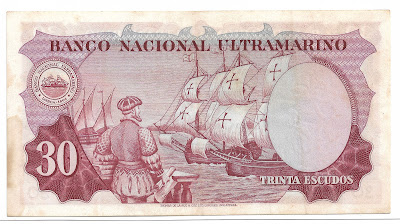1853) A 30 Escudo Banknote (1959), Goa, Portuguese India: Printed by Banco Nacional Ultramarino in 1959, this Banknote was in circulation in Portuguese Goa, India:
The Escudo was the currency of Portuguese India between 1958 and 1961. It was divisible into 100 centavos and was equal in value to the Portuguese Escudo.
In 1958, the Escudo replaced the Rupia at the rate of 1 Rupia = 6 Escudos.
After Portuguese India was annexed by the Republic of India in 1961, the Escudo was replaced by the Indian Rupee.
Coins:
Coins were introduced in 1958 in denominations of 10, 30 and 60 Centavos, 1, 3 and 6 Escudos. The 10 and 30 Centavos were struck in bronze, the others in Cupro-nickel. Except for the 10 Centavos, which was minted in 1961, none of these coins were produced after 1959. All of them are common.
Banknotes:
In 1959, standard Banknotes were introduced by the Banco Nacional Ultramarino in denominations of 30 (Red), 60 (Violet), 100 (Blue), 300 (Red), 600 (Green) and 1000 (Brown-green) Escudos.
The Front of the 30 Escudo Banknote shows a portrait of Alfonso de Albuquerque to the right. At left is seen a watermark window.
The numeral 30 (international numerals) is inscribed in all four corners.The inscriptions on this face are - "BANCO NACIONAL ULTRAMARINO", "INDIA PORTUGUESA", "TRINTA ESCUDOS", "LISBOA,", "2deJANEIROde1959" (meaning "Banco Nacional Ultramarino, India Portuguesa, Thirty Escudos, Lisbon,2nd January 1959".
The languages appearing on the Banknote are Marathi. Urdu, Gujarati and Konkani.
The Back of the 30 Escudo Banknote shows a picture of "Alfonso de Albuquerque and Portuguese ships".
Also seen is the watermark window to the right. At top left is the seal of BANCA NACIONAL ULTRAMARINO.
The size of this Banknote is 140.0 mm x 75 mm and its predominant colour is red and multi-colour.
There are two signature variants usually seen for this Banknote:
1. Signatures: Gastão Bessone Basto & Francisco José Vieira Machado
2. Signatures: António Julio de Castro Fernandes & Francisco José Vieira Machado.
Tailpiece: Alfonso de Alburquerque used to bring with him a variety of mangoes on his sea-voyages to India. He grew one of these varieties in India.
This mango variety is still grown in the Indian State of Maharashtra, particularly in Ratnagiri district, and the mango has been named after him - Alfonso!!
It is the most popular mango variety in the State.
6) "The Joker", Portugal: Portugal Post has issued a set of four stamps featuring "The Joker"character of DC Comics, who is an archenemy of the "Batman": Date of Stamp issue: 31.03.2020
7) Portuguese Numismatics (1st Group): A set of four Stamps in the values of N20g, A20g, E20g and 120g issued by CTT Correios (Portuguese Post) in partnership with INCM ("Imprensa Nacional-Casa da Moeda (the "Portuguese Mint & Official Printing Office") depicting coins from various periods of history: Date od Stamp set issue: 22.04.2020
12) "Linha Do Douro" ("The Douro Line (Train)", Portugal:12th Coin in the Ibero-American Coin Series titled "Historic Trains" brought out by the "Imprensa Nacional-Casa da Moeda" (INCM): Date of issue: 06/2020
9) "Nacional Museo del Prado", Spain: Celebrating the Bicentenary milestone (1819-2019): Commemorative Silver Coins of 30 Euros issued by Fabrica Nacional de Moneda y Timbre - Casa Real de la Moneda on 20.11.2019: Coins minted by the Madrid Mint
12) The New Silk Road: A Joint issue of a two stamp set of 1.50 Euros each by Spain (Correos Post) and China: Stamps issue date: 01.07.2019
13) Charming Towns, Spain : For the past five years, Correos (Spanish Post) has issued Stamps and Postcards on four beautiful Spanish villages as old-fashioned accordion-style postcards: Date of PostCards/Stamp set issue: 30.03.2020
14) "International LGBTQ Pride Day", Spain: The LGBTQ Pride Day Flag (Rainbow Flag) depicted on the first ever stamp issued: Date of Stamp issued: 15.06.2020
15) "Card Games", Spain: Correos Espana (Spanish Post) has issued a Stamp Sheet of 3.80 Euros representing the four suits (Swords, Pentacles, Cups & Wands) in a Tarot Deck, as the Origins of Card Games: Date of Stamp Sheet issue: 02.07.2020
6) Leonardo da Vinci, France: The latest issue from the Monnaie de Paris, France highlights him on the latest Europa Silver Star Coin Programme issued by the Paris Mint: Coin issue date: 03/2019
7) i) "Europa Coin Programme" or the "European Star Programme" or the "Eurostar Programme" ii) Central Bank of Malta issues 50 Euro (Gold) and 10 Euro (Silver) Proof Coins featuring "Architecture and artwork of the Gothic Era" in 05/2020 (which is a part of the wider programme focussing on the ages of Europe: Date of Coins issue: 08.05.2020




Vikram Bhatnagar has commented:
ReplyDelete"Looks eerily similar to the fiat that we use in India today!"
It does indeed, Vikram. However, apart from the watermark, the other security features were quite rudimentary on this Banknote. Today's Banknotes are quite good with their security features. This Note is in a mint condition quality. My friend paid a huge amount to get it in his collection.
DeleteRajan Trikha has commented:
ReplyDelete"Very interesting n informative 👍"
Thank you, Trikha sahab. Alphonso is the Portuguese duke/governor after who the Alphonso mango of Ratnagiri, India is named, which he used to bring with him on his sea voyages to India. The variety found the Indian climate very conducive for it to grow here.
ReplyDeleteRajan Trikha has further commented:
Delete"Thanks for more updates."
Satish Srivastava has commented:
ReplyDelete"Great and refreshing information."
Thank you, Satishji.
DeleteRsanker Sharma has commented:
ReplyDelete"Great post.. Very interesting."
Thank you so much, Sharma sahab.
DeleteAshok Borate has commented:
ReplyDelete"ग्रेट ईनफारमेशन."
Thank you, Ashokji.
Delete